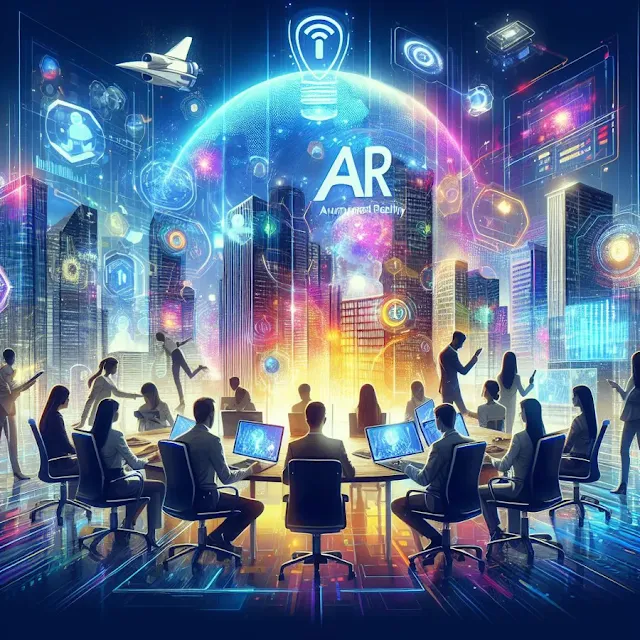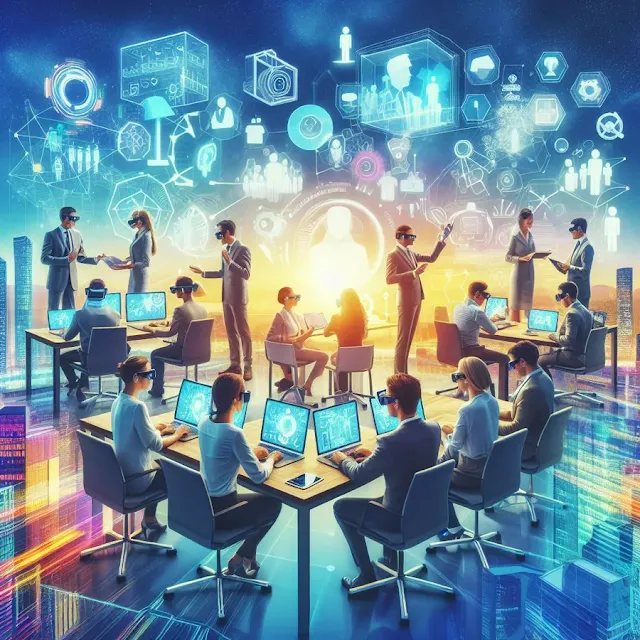Augmented Reality and the Workplace: The Future of Collaboration and Training
1.1 Defining Augmented Reality
1.2 Evolution of AR in the Workplace
2. Augmented Reality in Collaboration
2.1 Transforming Communication
2.2 Virtual Meetings in AR
2.3 Remote Collaboration Enhanced
3. AR in Training and Skill Development
3.1 Immersive Learning Environments
3.2 Hands-on Training with AR
3.3 Real-time Feedback and Assessment
4. Case Studies: Successful AR Implementations
4.1 Industries Embracing AR
4.2 Positive Impact on Productivity
5. Overcoming Challenges in AR Integration
5.1 Technological Barriers
5.2 Employee Training and Acceptance
5.3 Privacy and Security Concerns
6. Future Trends in AR and Workplace Dynamics
6.1 Integration with Artificial Intelligence
6.2 Wearable AR Devices
6.3 Customized Solutions for Different Industries
7. Conclusion
1. Introduction
Augmented Reality (AR) has transcended its origins in gaming and entertainment, making significant strides in transforming various aspects of our lives. One arena where AR is making a profound impact is the workplace. This article delves into the role of Augmented Reality in shaping the future of collaboration and training within professional environments.
1.1 Defining Augmented Reality
Before we explore the applications of Augmented Reality in the workplace, let's briefly define what AR entails. Augmented Reality refers to the integration of digital information with the user's real-world environment in real time. Unlike Virtual Reality (VR), which immerses users in a completely virtual environment, AR overlays digital content onto the physical world, enhancing our perception of reality.
1.2 Evolution of AR in the Workplace
The adoption of AR in professional settings has evolved over the years, driven by advancements in technology. Initially, AR found its footing in fields like medicine and military training. However, with the advent of more accessible and powerful devices, AR has now permeated various industries, promising to revolutionize how we collaborate and train in the workplace.
2. Augmented Reality in Collaboration
2.1 Transforming Communication
In a globalized and digitized world, effective communication is paramount. Augmented Reality introduces new dimensions to communication by enabling users to share information in a more immersive and interactive manner. For instance, employees can visualize complex data sets, 3D models, or architectural designs right in front of them, fostering better understanding and collaboration.
2.2 Virtual Meetings in AR
The traditional concept of virtual meetings is undergoing a paradigm shift with AR. Instead of conventional video conferences, AR enables participants to join virtual spaces where they can interact as if they were physically present. This not only enhances engagement but also reduces the limitations of remote communication.
2.3 Remote Collaboration Enhanced
AR is breaking down the barriers of physical distance. Remote teams can collaborate more seamlessly through AR applications that allow shared workspaces and real-time interaction with digital elements. This is particularly beneficial for industries with geographically dispersed teams, promoting a sense of unity and shared purpose.
3. AR in Training and Skill Development
3.1 Immersive Learning Environments
Training programs are undergoing a transformation with the incorporation of Augmented Reality. Instead of traditional methods, employees can now immerse themselves in realistic, simulated environments. This hands-on approach enhances retention and understanding, making training more effective.
3.2 Hands-on Training with AR
Certain professions require hands-on experience for skill development. AR addresses this need by providing simulated scenarios where employees can practice and refine their skills in a risk-free environment. From medical procedures to machinery operation, AR offers a safe yet realistic training ground.
3.3 Real-time Feedback and Assessment
AR facilitates real-time feedback during training sessions. This immediate evaluation allows employees to adjust and refine their actions, leading to more efficient learning outcomes. Managers can also track progress and identify areas that may need additional attention, ensuring continuous improvement.
4. Case Studies: Successful AR Implementations
4.1 Industries Embracing AR
Numerous industries are reaping the benefits of AR integration. Manufacturing, healthcare, education, and retail are just a few examples. For instance, in manufacturing, AR is used to guide assembly line workers with step-by-step visual instructions, reducing errors and increasing efficiency. In healthcare, AR assists surgeons by providing detailed anatomical information during procedures.
4.2 Positive Impact on Productivity
Companies that have embraced AR in their workflows report significant productivity improvements. The ability to access information more efficiently, coupled with enhanced collaboration, results in streamlined processes. Employees can perform tasks more accurately, reducing errors and minimizing downtime.
5. Overcoming Challenges in AR Integration
5.1 Technological Barriers
While the potential benefits of AR are immense, there are challenges to overcome. Technological barriers, such as the need for powerful devices and high-speed connectivity, can hinder widespread adoption. However, as technology continues to advance, these barriers are gradually being addressed.
5.2 Employee Training and Acceptance
Integrating AR into the workplace requires a shift in mindset and skill set. Employees need proper training to harness the full potential of AR tools. Additionally, there may be resistance to change. Clear communication and demonstrating the practical benefits of AR are crucial in overcoming this hurdle.
5.3 Privacy and Security Concerns
The collection and processing of data in AR applications raise privacy and security concerns. Companies must prioritize data protection and establish robust security measures to safeguard sensitive information. Transparency in data usage and adherence to privacy regulations are essential for building trust among users.
6. Future Trends in AR and Workplace Dynamics
6.1 Integration with Artificial Intelligence
The convergence of AR and Artificial Intelligence (AI) is on the horizon. Combining AR's ability to enhance the real world with AI's cognitive capabilities opens up new possibilities. Smart AR applications can provide context-aware information, personalized recommendations, and even predictive analytics, further optimizing workplace processes.
6.2 Wearable AR Devices
The shift towards wearable AR devices is gaining momentum. Smart glasses, for example, offer a hands-free experience, allowing users to access information while performing tasks. This trend not only enhances user experience but also contributes to increased efficiency and safety in various industries.
6.3 Customized Solutions for Different Industries
As AR technology matures, we can expect to see more industry-specific applications tailored to the unique needs of different sectors. Whether it's in healthcare for patient care simulations or in education for immersive learning experiences, AR solutions will become increasingly specialized, maximizing their impact.
7. Conclusion
In conclusion, Augmented Reality is poised to redefine how we collaborate and train in the workplace. From revolutionizing communication to providing immersive training experiences, the applications of AR are vast and diverse. As technology continues to advance and organizations adapt to these changes, the workplace of the future will undoubtedly be shaped by the transformative power of Augmented Reality. Embracing this revolution is not just an option but a necessity for staying competitive in an ever-evolving professional landscape. The journey towards a more augmented workplace has only just begun, and the possibilities are limitless.



